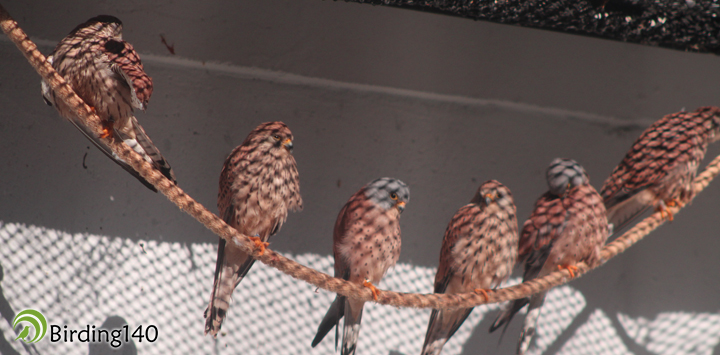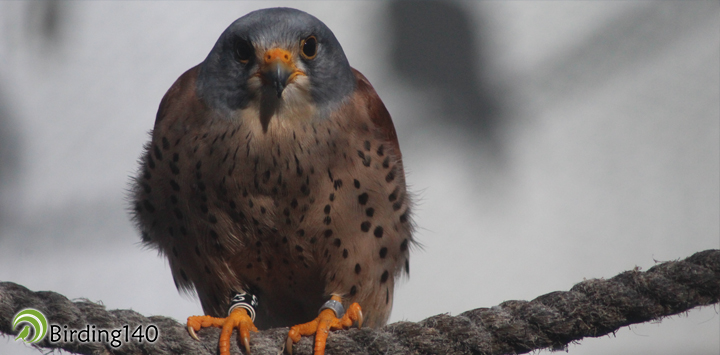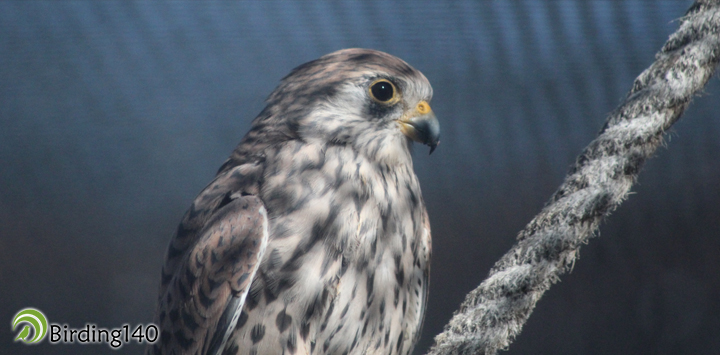Behind the surveillance glass in the observation room visitors silently the activity of the Lesser Kestrel breeding colony. This is one of the nucleus of colonial breeding, especially designed in an octagonal shape. Its large dimensions allow specimens to take circular flights at great speed. We must say that the bulk of this breeding nucleus is formed by individuals with physical and behavioural deficiencies.

Lesser Kestrel (Falco naumanni)
The current breeding system is exclusively natural: no incubators are used, which favours captive colonies to have the same patterns and biological times as any natural colony. In the DEMA breeding centre for the Lesser Kestrel in Almendralejo (Badajoz), each year are born dozens of specimens that will be released in the natural environment, at the age of 18-20 days, using the method “colony environment”, designed by DEMA, with the aim of recovering former colonies or creating new ones.
For 25 years, DEMA has been recovering populations of this small urban falcon in communities like Extremadura, Castile-La Mancha, Madrid, La Rioja, Valencia and Andalusia. Nowadays, national projects are being developed in Sierra de San Pedro (Cáceres) and Bardenas Reales (Navarra). At international level, a LIFE project was developed for the recovery of the Lesser Kestrel in L’Aude (France), and there is another LIFE project in Bulgaria to recover the species, extinct in this Balkan country.
DEMA completes these conservation actions with environmental education measures and research studies focused on the genetics and behaviour of the species, in collaboration with researchers from the Spanish National Research Council (CSIC), from the Doñana Biological Station (EBD).
To deepen further in these projects, we had an exclusive interview with Pepe Antolín, the real engine of this NGO.
- Question: To those unfamiliar with DEMA’s actions, can you talk about the developed and ongoing projects?
- Answer: At the beginning of the 1990s, a captivity breeding program that had been emerging started to take shape. This is the first project in the world of conservation of endangered species that manages to breed the Lesser Kestrel in captivity in Extremadura. At the same time, DEMA develops a pioneer programme in environmental education, where volunteers play the essential role of building the foundation for a project summarised in a potent slogan: “Almendralejo, human heart for the Lesser Kestrel”.
- From here, a group of volunteers “forces” the Almendralejo council to give away one of the houses that had been occupied by teachers in previous years. This is the beginning of the new nature school, and the first captivity breeding programme for the Lesser Kestrel. The kitchen was repurposed as the setter room, one of the rooms turned into a vivarium to breed mice, another one turned into a small quail farm, and a third one was refurbished a studio with a room in the back to breed grasshoppers. The living room was a meeting area, library, nature school and office. In the yard, there were 10 small breeding nucleuses with several breeding couples of Lesser Kestrel. There was still room in the outside corridors to recover White Stork chicks and some other birds of prey that frequently arrived after being shot.
- The beginning of the DEMA programmes that are currently under development couldn’t be more endearing and promising. They broke the mould to such an extent that they keep doing it 25 years later.
- The first reintroduction project was developed in Palomas (Badajoz), a small village where the species was extinct since 1960. Like happened with many other projects after that, the expenses were funded by the volunteers themselves.

Lesser Kestrel (Falco naumanni)
- Q: 2. In 1990 was created the modern DEMA Lesser Kestrel breeding centre; in 1996 they put into operation an unprecedented collective breeding system that additionally complements the exclusive method of chick release “colony environment”. But do these ideas come up?
- A: These approaches come from a personal concern, not being satisfied with the establishment and researching new fields to improve working plans, breeding and releasing systems and, in essence, to give the species we work with the highest degree of dignity and quality of life.
- Q: Let’s imagine that a town wants to have a Lesser Kestrel population and asks you for advice. Which requirements should they meet in order to host a colony?
- A: In order to start an introduction or reintroduction project for the Lesser Kestrel, it is necessary to conduct a preliminary feasibility study. It is crucial to know if the planned area for the releasing programme has ever hosted a colony, how many years ago it disappeared and what was the reason for that.
- On the other hand, there is also the possibility of boosting an undermined colony that used to have large numbers and that is now at risk of disappearing. In those cases, we proceed to plan the action, visit the area, evaluate all the parameters that have negatively affected the colony’s numbers and therefrom propose the necessary actions to reverse the trend.

Lesser Kestrel (Falco naumanni)
- Q: 4. If an individual has a house in a rural area with favourable conditions, can they purchase an install one of the artificial nest boxes you offer?
- A: Anyone who wishes so can install an artificial nest box in their house, but this doesn’t mean that a Lesser Kestrel will occupy it. If the species doesn’t breed in the area, the nest will most likely be occupied by a couple of sparrows or starlings.
- Q: 5. Are there differences between the reintroduction programmes developed in Spain and those developed in Bulgaria or France? Do Lesser Kestrels suffer the same threats and problems throughout the whole European continent?
- A: The problems Lesser Kestrels face in Spain are very similar to the problems they have in any enclave in the Mediterranean zone where this species breeds. Because the species is very linked to traditional non-irrigated crops and steppe areas, systematic crop changes and the elimination of frequent hunting grounds are some of the most important factors that limit their presence.
- Also, restoration in buildings whose spaces are eliminated and the substitution of Arabic tile by metal covers or modern tiles prevent the species from finding shelter to breed and thus they move to other spaces or disappear from the area. Furthermore, the intensive use of phytosanitary products and pesticides in agriculture has made the species disappear in countries like Bulgaria, and almost in Spain at mid-twentieth century. The Lesser Kestrel was one of the most abundant birds of prey in Europe. After this kind of man-made actions, it has become one of the most threatened species.
- Q: We are reaching the end of the interview and some of our readers might be wondering how then can collaborate with DEMA’s projects. How can they do it? How does sponsorship work for one of these winged jewels?
- A: They just need to contact DEMA.
- Q: To conclude, we will ask you to exclusively reveal a future project that you have in mind or that you would like to develop to improve the future of the species?
- A: The project I have in mind every day is devoting more time to marketing: how to convince individuals, businesses or entities that manage resources to invest in conservation, as this is one of the core issues to effectively carry out actions that benefit the breeding habitats and the feeding of the Lesser Kestrel.
From these lines, we thank Pepe Antolín for his time and willingness to do this interview. We hope to establish a collaboration with DEMA and spread their projects and actions in favour of these falcons so linked to the human environment. We promise to come back soon to your facilities. Thank you, DEMA.











